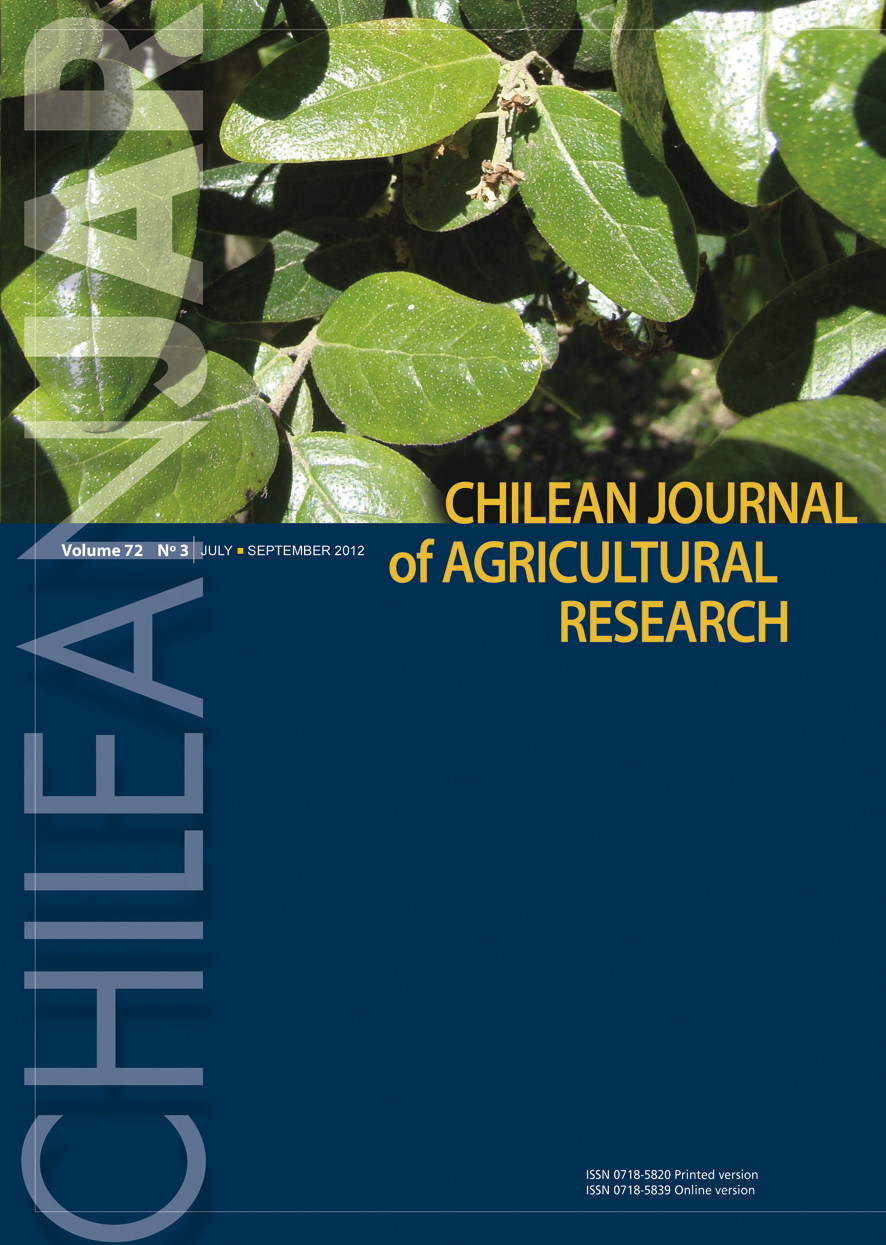
|
Chilean Journal of Agricultural Research
Instituto de Investigaciones Agropecuarias, INIA
ISSN: 0718-5820
EISSN: 0718-5820
Vol. 69, No. 1, 2009, pp. 3-11
|
 Bioline Code: cj09001
Bioline Code: cj09001
Full paper language: Spanish
Document type: Research Article
Document available free of charge
|
|
|
Chilean Journal of Agricultural Research, Vol. 69, No. 1, 2009, pp. 3-11
| en |
Evaluation of Water Requirements for a Greenhouse Tomato Crop Using the Priestley-Taylor Method
Valdés-Gómez, Héctor; Ortega-Farías, Samuel & Argote, Mauricio
Abstract
The Priestley-Taylor (PT) model was evaluated for estimating the real evapotranspiration (ETreal) of a drip-irrigated greenhouse tomato ( Lycopersicon esculentum

Mill.) crop. The net radiation incorporated in the PT model was estimated using meteorological variables. For this experiment, an automatic weather station (AWS) was installed inside the greenhouse to measure solar radiation (Rgi), net radiation (Rn), air temperature (Ta) and relative humidity (RH). Another AWS was installed over a grass cover to measure atmospheric conditions outside the greenhouse. The experiment was carried out at the Panguilemo experimental station (35°23' S, 71°40' W, 110 m.a.s.l.) from August to December 2000. The PT model was evaluated using the ETreal obtained from the water balance (WB) method. In this case, values of ETreal by PT model were calculated using: a) Rgi and soil heat flux (G) = 0; b) Rgi and G ≠ 0; c) solar radiation measured outside the greenhouse (Rge) and G = 0; and d) Rge and G ≠ 0. For these cases, results indicated that PT model was able to compute ETreal with errors less than 5%. Also, Rn was calculated with a relative absolute error and a mean deviation lower than 6% and 0.07 mm d-1, respectively, using Rgi or Rge. Daily soil heat flux values equal to zero did not affect the calculation of ETreal values. Thus, the PT model evaluated in this study could be used for scheduling irrigation for a greenhouse tomato crop, using internal measurements of air temperature and relative humidity, and external measurements of solar radiation. In this case, PT model predicted the ETreal with an error of 6.1%.
Keywords
irrigation, Lycopersicon esculentum, model, crop coefficients, net radiation, soil heat flux.
|
| |
| es |
Evaluación del Consumo de Agua de un Cultivo de Tomate en Invernadero Usando el Método de Priestley-Taylor
Valdés-Gómez, Héctor; Ortega-Farías, Samuel & Argote, Mauricio
Resumen
Se evaluó el comportamiento del modelo de Priestley-Taylor (PT) para la estimación de la evapotranspiración real (ETreal) de un cultivo de tomates ( Lycopersicon esculentum

Mill.) en condiciones de invernadero. La radiación neta incorporada en el modelo de PT fue calculada usando variables meteorológicas clásicas. Para este experimento, una estación meteorológica automática (AWS) fue instalada dentro del invernadero para medir radiación solar (Rgi), radiación neta (Rn), temperatura del aire (Ta) y humedad relativa (RH). Una segunda AWS fue establecida sobre una cubierta herbácea para medir las condiciones atmosféricas al exterior del invernadero. El experimento se condujo en la Estación Experimental Panguilemo (35°23’ S, 71°40’ O, 110 m.s.n.m.) durante los meses de agosto a diciembre del 2000. Las estimaciones de ETreal obtenidas por el modelo PT fueron comparadas con los valores calculados por el método del balance hídrico (WB). En este estudio los valores de ETreal obtenidos por PT fueron calculados usando: a) Rgi y flujo de calor del suelo (G) = 0; b) Rgi y G ≠ 0; c) radiación solar medida al exterior del invernadero (Rge) y G = 0; y d) Rge y G ≠ 0. Para estos casos los resultados indicaron que el modelo de PT fue capaz de estimar la ETreal del tomate con errores menores que un 5%. Asimismo, la Rn fue calculada con un error absoluto relativo y una desviación media de no más del 6% y 0,07 mm d-1, respectivamente, ya sea utilizando Rgi o Rge. La utilización de un valor igual a cero para valores diarios de flujo de calor del suelo no afectó el cálculo de los valores de ETreal. Así, el modelo de PT evaluado en esta investigación podría ser usado para programar el riego de un cultivo de tomates bajo invernadero usando mediciones internas de temperatura y humedad relativa, y mediciones externas de radiación solar. En este caso, el modelo de PT predijo la ETreal con un error de un 6,1%.
Palabras-clave
riego, modelo, Lycopersicon esculentum, coeficientes de cultivo, radiación neta, calor del suelo.
|
| |
© Copyright 2009 - Universidade de Santa Cruz do Sul
Alternative site location: http://www.inia.cl
|
|
